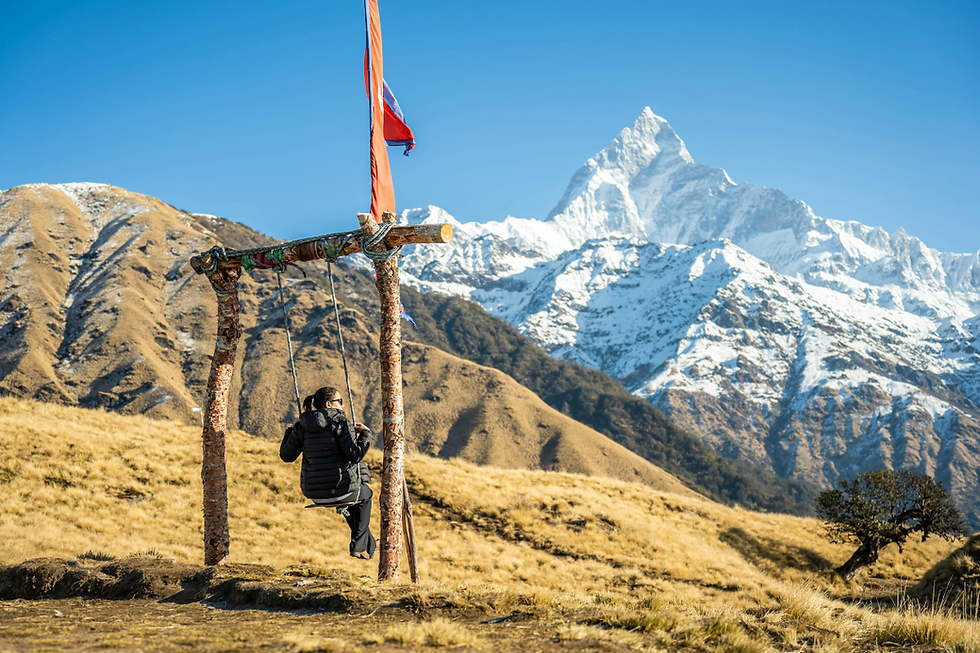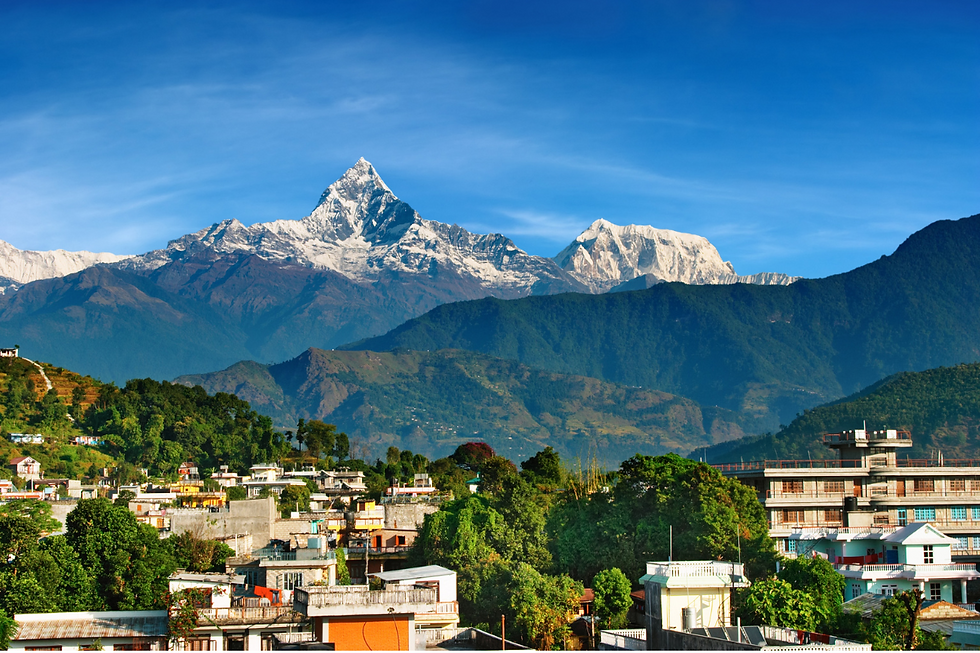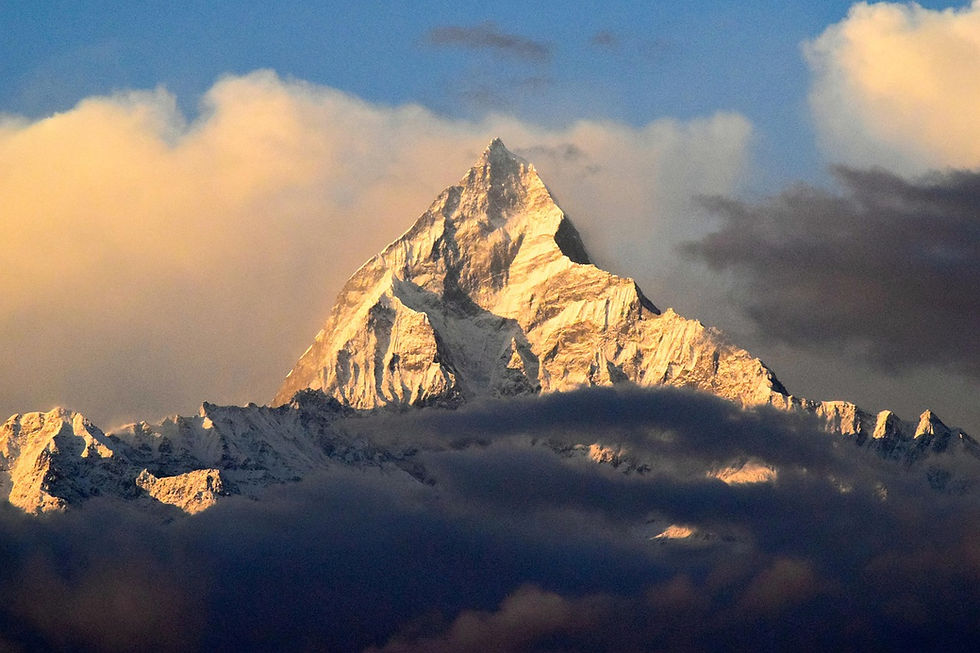Annapurna Circuit Trek Overview: Classic Nepal Himalayan Trek 2025
- rockykauffmanmarke
- Jul 26
- 9 min read

The Annapurna Circuit is a famous long-distance trail in Nepal’s Himalayas. It circles the Annapurna mountain range, passing through forests, fields, and alpine deserts. Trekkers enjoy amazing views of high peaks like Annapurna I (8,091 m) and Dhaulagiri (8,167 m. The route is approximately 170–200 km (105–125 miles) long and typically takes 15–18 days to complete. It was opened to trekkers in 1977 and remains a classic adventure (about 70,000 people hike it each year. The highest point is the Thorong La Pass (5,416 m), and crossing it is the trek’s big highlight.
Trekkers enjoy panoramic views of the Annapurna range, including high peaks like Annapurna I and Dhaulagiri. The trail winds for 170–200 km through varied scenery – from subtropical forest and terraced fields to high rhododendron forests and dry alpine landscapes. It crosses the Thorong La pass (5,416 m), the trek’s highest point. Each day brings new village and mountain views, making the journey both challenging and rewarding.
Annapurna Circuit Trek Route and Itinerary: Best Route, Key Villages & Map
Trek Route
The classic Annapurna Circuit starts in Besisahar (or nearby Jagat) and loops clockwise through the Manang District, ending in the Mustang District. The trek finishes at Nayapul/Jomsom (then drive or fly to Pokhara. Many people then return to Pokhara or Kathmandu. Along the way, you pass key stops like Dharapani, Chame, Pisang, Manang (a good acclimatization village., Yak Kharka, Thorong Phedi, and Thorong La. After the pass, you descend to Muktinath (3,800m) and then onward through Tatopani (hot springs), Ghorepani (Poon Hill), and Ghandruk. A map is very useful here seeing the circuit loop and mountain passes helps understand the trail. (For example, maps show the route is circular and oriented anticlockwise through the peaks.
Starts: Besisahar/ Jagat (drive from Kathmandu in 8–10 hours
Ends: Nayapul/Jomsom (drive or flight onward to Pokhara
Major villages: Dharapani (1,860m), Chame (2,670m), Pisang (3,300m), Manang (3,540m), Yak Kharka (4,090m), Thorong Phedi (4,450m), Thorong La (5,416m), Muktinath (3,800m)
Many trekkers also choose an optional side trip to Tilicho Lake before rejoining the main trail (see below).
Trek Duration and Distance
A typical full circuit takes 15–18 days of hiking, plus travel days. Shorter or faster itineraries (skipping acclimatization days) can be completed in about 12 days, while longer ones (with side trips) may take 20 days or more. The total hiking distance is roughly 170–200 km. (This varies: a “Short Annapurna Circuit” route of 6–12 days covers about 100–160 km, focusing on high passes and skipping lower sections. Expect to hike 5–7 hours most days (6–10 km), with some shorter acclimatization walks. Many trekkers also hike to Ghorepani (Poon Hill) for sunrise views on the way out, which can add 1–2 days.
Trekking Map
A detailed map or GPS route is highly recommended for planning. As one guide notes, “Seeing a map of the Annapurna Circuit helps you to understand the geography of the region and the challenge involved.. The map clearly shows the loop around the Annapurna massif, the high Thorong La pass, and side valleys like Tilicho and Nar-Phu. Having a visual route map (on paper or phone) helps with navigation and scheduling camps/teahouses each day.
Annapurna Circuit Trek Cost Breakdown 2025: Permits, Guide, Food & Transport
Costs (Permits, Guides, Food, etc.)
Nepal requires an Annapurna Conservation Area Permit (ACAP) for this trek, which costs approximately NPR 3,000 (~$25–30 USD) per foreign trekker. As of 2023, a former Trekkers’ Information Management System (TIMS) card is no longer required. Licensed guide services are now mandatory for foreigners, which adds to the cost. In practice, plan on roughly:
Guide fee: ~$20–25 USD per day (covers guide’s food, lodging, and insurance
Porter fee: ~$12–15 USD per day (shared between two trekkers)
Food & lodging: Around $25–30 USD per person per day, including three meals and a twin room in teahouses. For example, a Nepali meal of dal bhat costs a few dollars, and a basic lodge room is ~$5–10/night.
Transport: The bus from Kathmandu to Jagat (via Besisahar) costs approximately $6–10; a shared jeep may cost $20–30 (even cheaper if you share in a group). A bus or taxi from the end point (Nayapul/Jomsom) back to Pokhara is $5–10. A one-way flight from Pokhara to Kathmandu costs approximately $100 USD.
Tips: Porters and guides are often tipped ~$5–10 per day (shared between clients) at the trek’s end.
Visa: A 30-day Nepal tourist visa costs approximately $40 USD on arrival (prices vary by nationality).
Overall, many trekkers budget about $30–35 per day just for food/lodging. Plus guide/porter, permits, and travel. In total, a 2 week Annapurna Circuit trek typically costs $1,000–$2,500 (per person) when arranged through agencies. (Doing it fully independently can be cheaper on lodging/food, but still requires paying the same permits and guide fees.)
Is There WiFi on the Annapurna Circuit? Mobile Coverage & Connectivity
WiFi and Mobile Coverage
Most lodges now offer Wi-Fi (often free or for a small fee, $1–$ 4). Expect it to be slow and unreliable – usually enough to send messages or low-res photos, but not video. Some lodges in villages like Birethanti, Chame, Manang, Jomsom, and Thorong Phedi have WiFi. Charging your devices is usually possible in the evenings (often costing a few rupees per hour).
Mobile phone coverage is also decent. Three major Nepali networks (NTC, Ncell) work on most of the Circuit. Mobile signals now reach about 80% of the trail. The best network is often NTC, which gets 3G/4G up to Manang and beyond. SIM cards can be bought in Kathmandu or Pokhara with your passport.) Even at 4,000+ meters (Manang, Yak Kharka), you will often have at least some signal or voice reception. Still, always treat communications as a bonus download offline maps and carry a power bank.
Annapurna Circuit Trek Safety and Success Rate: Altitude Sickness Tips
Safety and Success Rate
The Annapurna Circuit is generally considered one of the safer high treks if done properly. Experienced guides report a 90–95% success rate when trekkers are well-prepared. The biggest risks are altitude sickness and weather. Above 2,500–3,000 m, your risk of Acute Mountain Sickness (AMS) rises sharply.. To stay safe, ascend slowly: take rest/acclimatization days (e.g., two nights in Manang) and drink plenty of water. If symptoms (headache, nausea, dizziness) appear, don’t go higher, descend, or rest.
The trail itself is well-established with hundreds of teahouses, but it has steep and rocky sections.
Monsoon season (June–Aug) brings slippery paths and landslides; winter brings snow above ~4,000 m. The safest months are spring (March–May) and autumn (September–November). Trekking over Thorong La is challenging due to thin air and weather swings (afternoon winds, cold), so guides plan to cross early in the day. Modern support (Himalayan Rescue clinics, helipads at lower altitudes, and exits by jeep) means help is available, but always trek conservatively. Proper preparation good sleeping gear, warm clothing, sunscreen, and a first-aid kit makes a big difference.
Tea Houses and Food on Annapurna Circuit Trek: What to Expect?
Tea Houses and Food
Accommodation on the Circuit is all in “tea houses” (guesthouse lodges). Rooms are basic but clean: expect two simple beds with a thin mattress and blanket. (In most places, you’ll have a private twin room for couples, though some popular spots like Ghorepani may have dorms.) Toilets are often squat-style or shared. Hot showers are available at many stops for a small extra charge (50–100 NPR). Electricity for charging devices is common in the evening (again, usually at a fee).
Teahouse meals vary with altitude. Lower down, you can choose Nepali, Tibetan, Indian, or even Western dishes. Dal bhat (rice with lentil soup) is the standard hearty meal (one serving is usually enough to fuel a day’s trek). You’ll also find momos (dumplings), noodles/thukpa, omelettes, chapati, and the occasional pizza or pasta. Meals cost roughly $3–6 each. Expect to pay a bit more (or have more limited options) above 4,000 m. Most trekkers spend around $25–30 per day on food and lodging combined. In short, you can eat well (plenty of starchy, warming Nepali food), but don’t expect luxury menus. It’s wise to carry some snacks (nuts, bars) for high camps.
Annapurna Circuit vs Annapurna Base Camp (ABC)
Many newcomers wonder which trek to pick. The Circuit is longer and higher, while the ABC trek is shorter and easier. A comparison:
Aspect | Annapurna Circuit | Annapurna Base Camp (ABC) |
Duration | ~14–21 days | ~7–12 days |
Distance | ~170–200 km loop | ~70–75 km round-trip (out-and-back) |
Highest Altitude | 5,416 m (Thorong La) | ~4,100 m (Base Camp) |
Difficulty | Moderate–Strenuous (extra high pass) | Moderate (no big passes) |
Scenery | Panoramic Himalayan loops: Annapurna, Dhaulagiri, Manaslu ranges | Close-up Annapurna views (I, IV, Gangapurna) plus dense forests |
Acclimatization | More rest days needed (Manang acclimatization) | Typically easier, but still stop in Chhomrong or Dovan |
Crowds | Less crowded (spread over more days) | Often busier (popular shorter route, includes Poon Hill) |
Season | Best: Mar–May, Sep–No (Thorong La can close in winter) | Best: Oct–Dec, Mar–May (can trek in mild winter too) |
Start/End | Besisahar/Jagat loop ends at Pokhara/Jomsom | Nayapul (drive to Pokhara) round trip out and back to Base Camp |
Tilicho Lake Side Trek on Annapurna Circuit: Itinerary & Difficulty
Optional Side Trek: Tilicho Lake
A popular side trip on the Circuit is Tilicho Lake (4,919 m), one of the world’s highest alpine lakes. Trekkers typically add 2–3 days after Manang to visit it. The detour is steep and strenuous (crossing Tilicho Base Camp), but very rewarding. You’ll climb to 4,920 m and see the turquoise lake nestled among glaciers. This requires good acclimatization (do it after a couple of nights in Manang or Yak Kharka). Many guides say Tilicho is “demanding yet rewarding” and only for fit hikers, but it adds a unique highlight to the trek. If you have extra time and want a memorable alpine lake, it’s worth it. Otherwise, you can skip Tilicho and continue on via Yak Kharka toward Thorong La.
Best Time to Trek Annapurna Circuit: Weather, Seasons & Trekking Tips
Best Time to Go
The best seasons for the Annapurna Circuit are spring (March–May) and autumn (September–November). These months have clear skies, stable weather, and colorful landscapes (rhododendron blooms in spring). Nights are cold but safe, and days are usually sunny. In monsoon season (June–Aug), the trail is very wet, landslides can close routes, and views are often blocked by clouds. Winter (Dec–Feb) is possible for experienced trekkers, but expect heavy snow on Thorong La and very cold nights.
For a shorter trip, consider the “Short Circuit” route: starting at Jagat/Bhulbhule and bypassing the first low sections. This cuts 4–6 days, focusing on Manang, Thorong La, and Muktinath. It still lets you cross the pass and see the high scenery, but in 6–12 days (100–160 km). If you want even more time, you could add the Nar-Phu valleys or do both the Annapurna Circuit and ABC sequentially, but that usually means 25–30+ days.
Hiring Guides for Annapurna Circuit Trek: Why It’s Mandatory & Helpful
Guides and Local Support
By law, foreign trekkers must hire a government-licensed guide. Guides provide security, navigation, and cultural insight. Local companies (like Himalaya Hub Adventure) take pride in experienced Nepali guides who know the trails and villages well. A good guide can arrange lodging and solve problems, letting you focus on hiking. Himalaya Hub, for example, emphasizes “expert guides” who share the local culture and tailor itineraries to each group. Hiring a guide or joining a reputable agency is recommended, especially for safety and getting the most out of the trek (it’s also now mandatory for foreigners. Porters can also be hired to carry extra weight, making the hike easier.

Frequently Asked Questions About Annapurna Circuit Trek 2025
Is it still worth doing the Annapurna Circuit?
Yes, the Annapurna Circuit is still worth it offering stunning views, remote villages, and a legendary high pass, despite some road development. It's a rewarding challenge for those ready for its length and altitude.
Why is Trekking in Nepal Expensive?
Costs are higher due to mandatory permits, guides, and rising logistics. Remote supplies are hard to access, so food and lodging cost more. Flights, jeeps, and gear add to the budget. New rules and real safety costs make trekking pricier than before.
How Safe is the Trek?
The Annapurna Circuit is safe with a high success rate. Main risk is altitude sickness above 3,000 m. Trails are well-marked with lodges and some medical help. Weather can change fast trek with a guide and be ready to descend if needed.
How much should I budget?
Expect to spend $30–35/day on food and lodging, plus ~$25/day for a guide. The ACAP permit is $30, and transport (buses, jeeps, flights) can add several hundred. Most trekkers budget $1,000–1,500 for a 2-week trip. You can save by choosing basic lodges and simple meals. Extras like hot showers, WiFi, tips, and snacks cost more carry extra cash in rupees.
How safe is it to trek alone?
Solo trekking isn’t allowed—foreigners must hire a guide. While villages are friendly, remote areas have limited help. Trekking with a guide (or group) is safer and often cheaper. Consider a porter if needed.
What gear do I need?
Bring sturdy boots, layered clothing, a -10°C sleeping bag, sunscreen, and a down jacket. Trekking poles, rain gear, and a first-aid kit help too. Most gear is rentable, but get good boots and a sleeping bag beforehand.
Overall, the Annapurna Circuit offers a classic Himalayan trek experience. With sensible preparation hiring a guide, packing right, and respecting acclimatization it remains highly worthwhile.
eforehand.



Comments